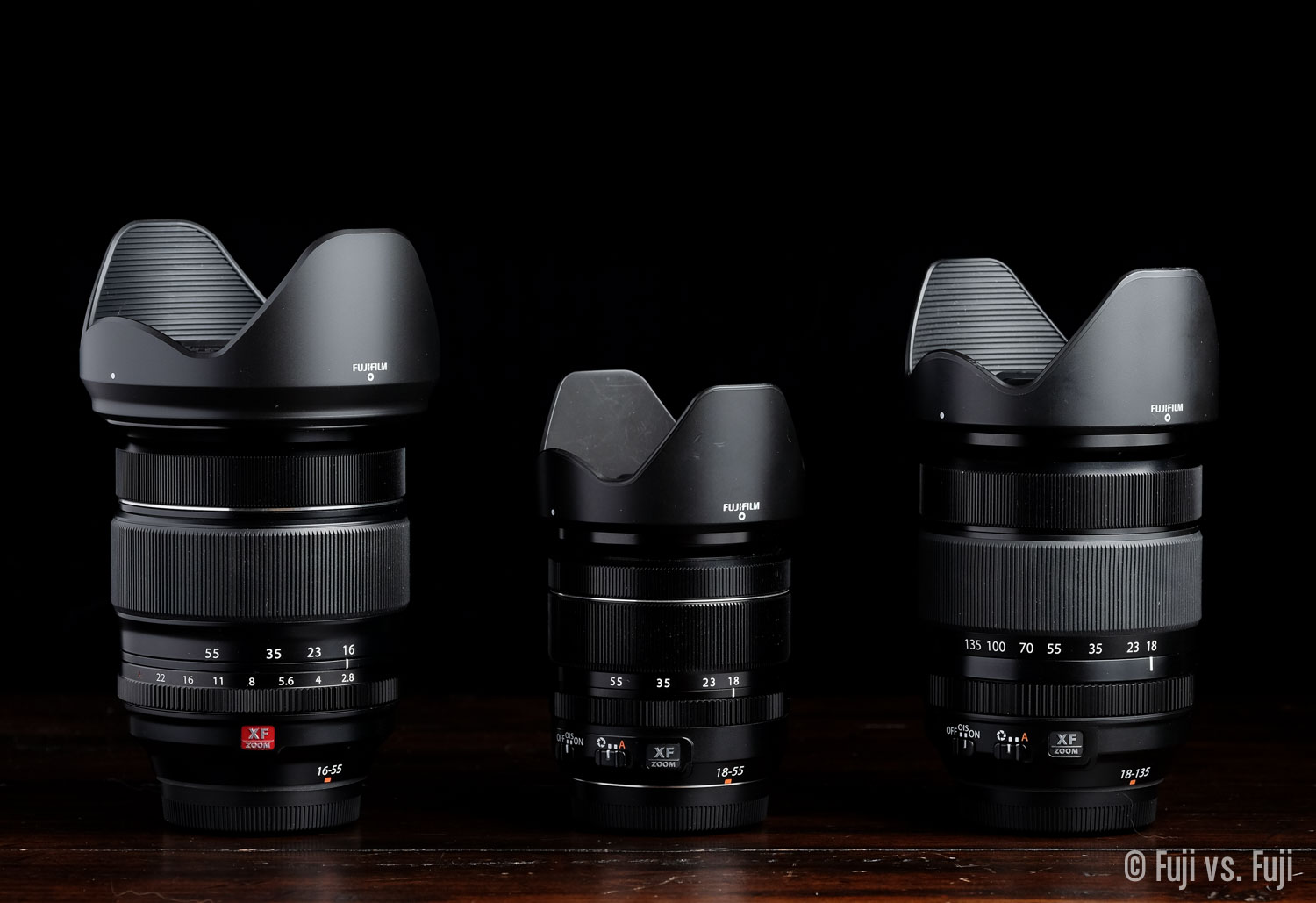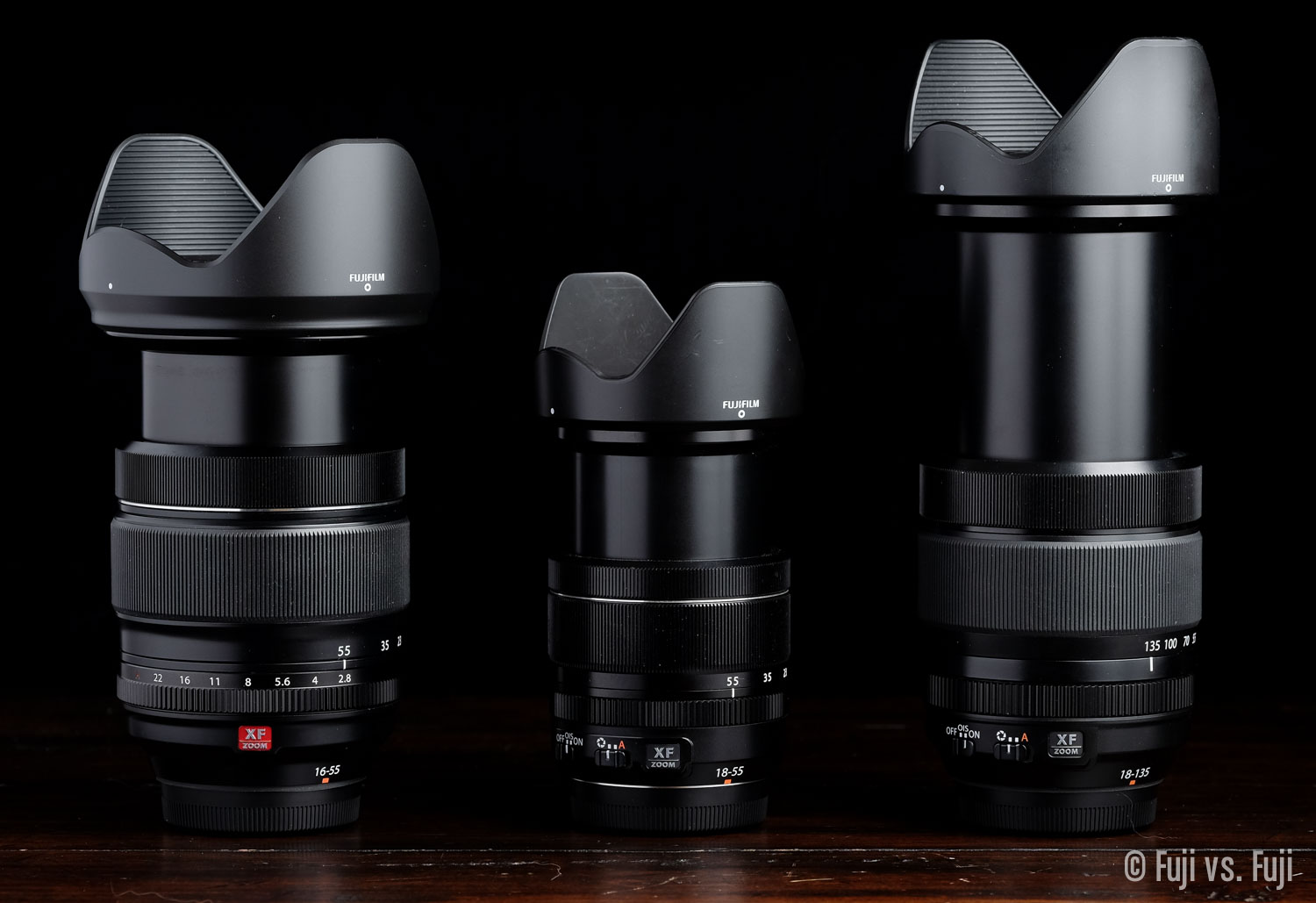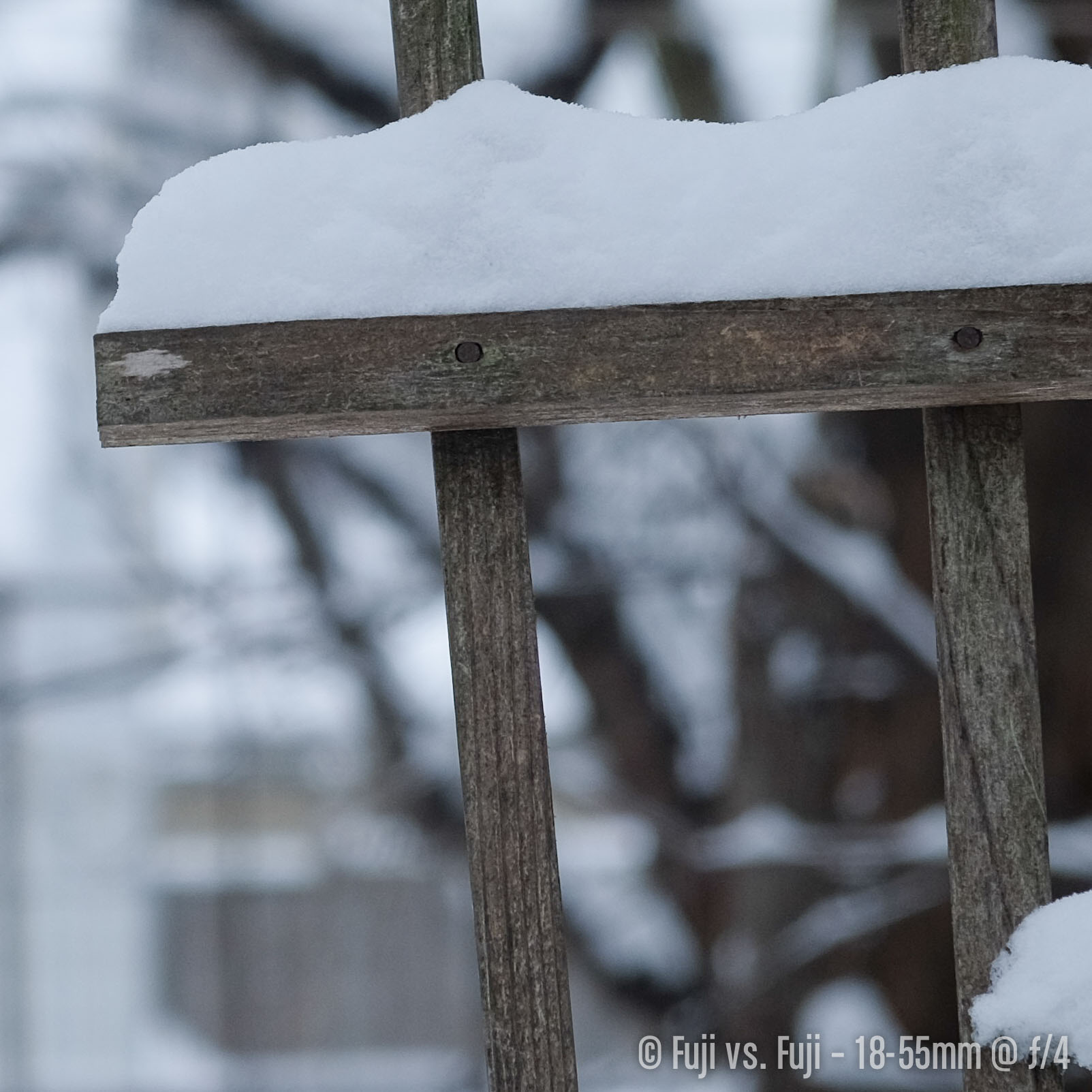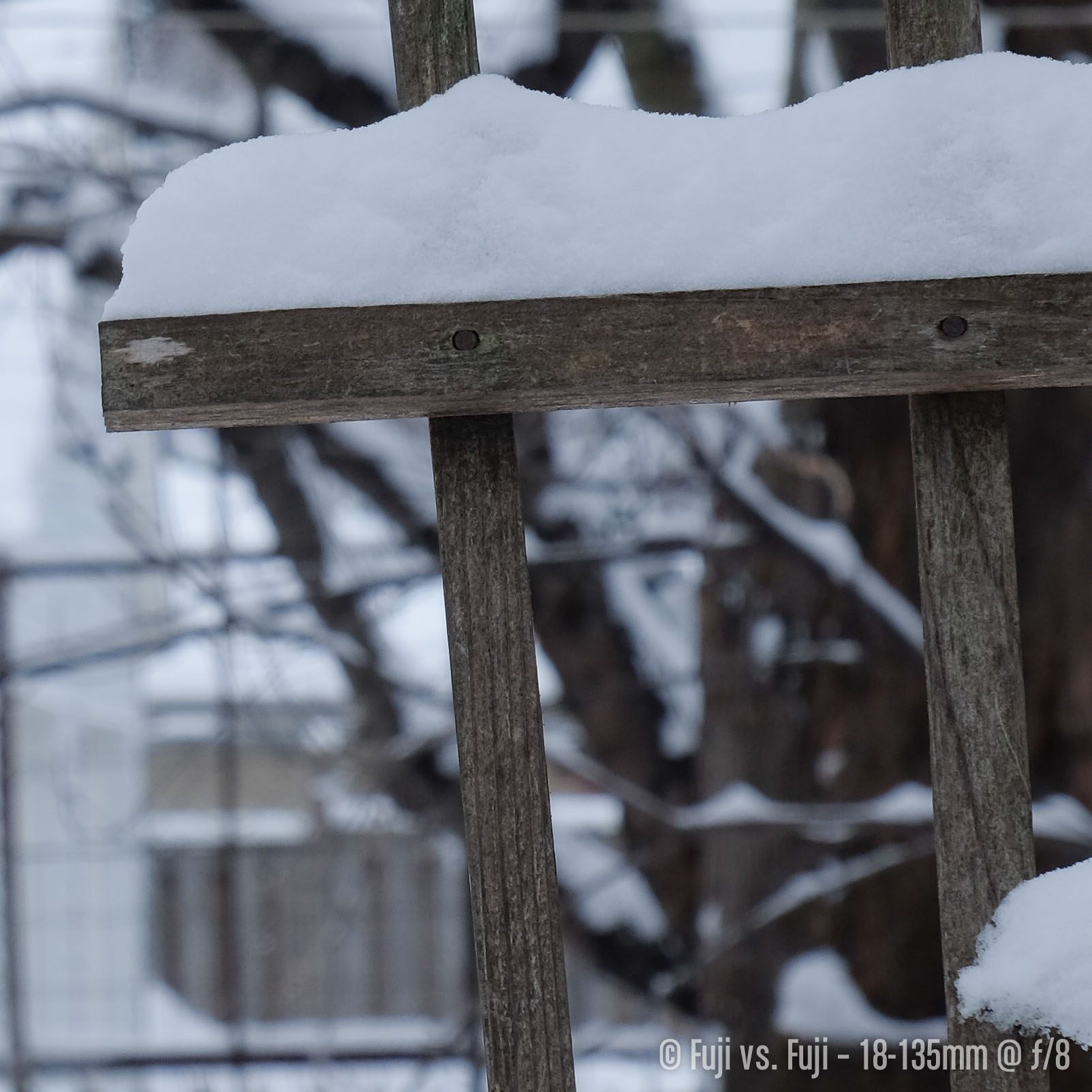Fujifilm XF 16-55mm F2.8 WR vs. XF 18-55mm F2.8-4 OIS vs. XF 18-135mm F3.5-5.6 OIS WR, a comparison of Fuji’s zooms.
February, 2015: Originally published
June, 2020: Minor revisions
Introduction
The standard zoom has long been a staple in almost every pro photographer’s bag. They are intended to be workhorses that can take just about anything we can throw at them. Low light, inclement weather, fast-moving subjects, you name it.
After a considerable wait, Fuji released a pro standard f/2.8 zoom, which—along with the XF 50-140mm F2.8 OIS WR (Review)—filled two big gaps in their lens lineup. These focal lengths could be reached before, but never with a constant aperture, and outside of 18mm, never at an aperture of f/2.8 as far as zooms were concerned. This piece will explore what you get for your extra money aside from more size and weight.
Specifications
| 16-55mm F2.8 | 18-55mm F2.8-4 | 18-135mm F3.5-5.6 | |
|---|---|---|---|
| Announced | January 6, 2015 | September 6, 2012 | June 16, 2014 |
| Released | February, 2015 | December, 2012 | August, 2014 |
| Price (MSRP) |
$1,199 | $699 | $899 |
| Lens Construction | 17 elements, 12 groups 3 aspherical, 3 extra low dispersion elements |
14 elements, 10 groups 3 aspherical, 1 extra low dispersion |
16 elements, 12 groups 4 aspherical elements, 2 anomalous dispersion lenses |
| 35mm Equivalent | 24.32 - 83.6mm | 27.36 - 83.6mm | 27.36 - 205.2mm |
| Angle of View | 83.2° - 29° | 76.5° - 29° | 76.5° - 12° |
| Aperture Range | f/2.8 | f/2.8 - f/4 | f/3.5 - f/5.6 |
| Focus Range | 0.3m (Macro) - Infinity | 0.3m (Macro) - Infinity | 0.45m (Macro) - Infinity |
| Maximum Magnification | 0.16x (Telephoto) | 0.15x (Telephoto) | 0.27x (Telephoto) |
| External Dimensions | 83.3mm diameter x 106.0mm - 129.5.9mm long | 65.0mm diameter x 70.4mm - 97.9mm long | 75.7mm diameter x 97.8mm - 158mm long |
| Weight (Measured) | 656g 719.5g w caps and hood |
308g 346g with caps and hood |
486g 530g with caps and hood |
| Filter Size | 77mm | 58mm | 67mm |
Features
| 16-55mm F2.8 | 18-55mm F2.8-4 | 18-135mm F3.5-5.6 | |
|---|---|---|---|
| Constant Aperture | Yes | No | No |
| Image Stabilization | No | Yes | Yes |
| Weather Sealed | Yes | No | Yes |
| Nano GI Coating | Yes | No | No |
| Brass Mount | Yes | No | No |
Build Quality
The XF 16-55mm F2.8 WR (Review) definitely feels as pro compared to the other two lenses in this comparison as any DSLR standard zoom does when stacked up against the kit lens. The XF 16-55mm F2.8 WR feels solid, like a tank. The XF 18-55mm F2.8-4 OIS (Review) was already a solidly-built lens, but this new pro zoom makes it seem wimpy by comparison. The XF 18-135mm F3.5-5.6 OIS WR is a little closer in size, but definitely not substance. Just look at the weight difference. There is all kinds of glass in that XF 16-55mm F2.8 WR.
Rings, Dials, and Switches
The aperture ring of the new zoom is a little more solid than the other two. Not XF 50-140mm F2.8 OIS WR solid, but definitely more rugged feeling. With the holding technique described below, I can actually turn the aperture ring with just one finger on either of the consumer zooms. With the XF 16-55mm F2.8 WR, I need my thumb to turn it comfortably. The zoom ring is also has a little bit more weight to it on the 16-55mm. It’s not as outstanding as the XF 50-140mm F2.8 OIS WR thanks to its telescoping front element, but especially compared to the XF 18-135mm F3.5-5.6 OIS WR, much more robust. My favourite zoom ring of three though, is the original XF 18-55mm F2.8-4 OIS. The metal is more grippy, it turns nice and smooth, and I can zoom through its entire range with a single turn.
There’s not a whole to write about on the focus ring front. The XF 16-55mm F2.8 WR’s feels a bit more consistent in its turning smoothness. The XF 18-135mm F3.5-5.6 OIS WR is where the biggest difference is. That missing chrome band between the zoom and focus rings seems to give the focus ring a tiny bit of play, and less smooth rotation. It’s not even close to anything that would affect day to day use.
As for switches, well, the XF 16-55mm F2.8 WR doesn’t have any. A marked aperture ring and lack of OIS leaves no need, so there really isn’t much to compare. The XF 18-55mm F2.8-4 OIS and XF 18-135mm F3.5-5.6 OIS WR are pretty much identical when it comes to switches, which is to be expected.
Handling
Size and Weight
The XF 16-55mm F2.8 WR is big. It’s also heavy. The small size and light weight of X-Series cameras can be a double-edged sword when it comes to beefier lenses like the two new pro zooms. An overall front-heavy camera is tough to avoid with a zoom, and impossible with the XF 16-55mm F2.8 WR. With the XF 18-135mm F3.5-5.6 OIS WR attached, even X-E bodies are unbalanced. The best mate for the size and ergonomics of Fuji’s smaller bodies is without question the 18-55mm f/2.8-4.
Weight
One Hand or Two
The XF 16-55mm F2.8 WR isn’t a lens you’re going to want to use one-handed for long. Add a second hand to your shooting, which you should, and the XF 16-55mm F2.8 WR handles great on any body. I can reach and adjust all three rings on the lens, and I don’t have large hands. My wife, whose hands are even smaller, needs to adjust her handholding in order to get at all the rings. A good hand position is to place your ring finger on the aperture, your middle finger on the zoom ring, your index finger on the focus ring (as needed), and move only your thumb among the three. The rings on both the XF 18-55mm F2.8-4 OIS and XF 18-135mm F3.5-5.6 OIS WR are equally accessible, and shooters with larger hands may find the XF 18-55mm F2.8-4 OIS a bit cramped.
Zooming
The XF 16-55mm F2.8 WR is shortest at around 19mm. In fact, the lens barely moves between 16 and 23mm, resulting in less overall protrusion, which is nice.
Both the XF 18-55mm F2.8-4 OIS and XF 18-135mm F3.5-5.6 OIS WR are at their shortest at 18mm, and they just get longer from there. This isn’t much of a problem with the little 18-55mm, but the 18-135mm gets real long, real fast.
Eye-blow
Another area the XF 18-55mm F2.8-4 OIS wins in is eye-blow. If there is any, I can’t feel it. With the other two lenses, you might dry your eye out if you zoom out too quickly. The XF 18-135mm F3.5-5.6 OIS WR is the worst here.
Hoods
It’s a pretty level playing field when it comes to hoods. All three lenses feature fairly large plastic scalloped hoods. The XF 18-55mm F2.8-4 OIS is missing the ridged interior instead of a much more matte yet smooth finish. It’s difficult to say which option would keep more stray light from hitting the front element.
The XF 16-55mm F2.8 WR’s hood has one extra ridge to the shape of the exterior that makes it even wider relative to the lens than the other two. To give you a sense of scale, the three hoods can be nested within each other as seen below. You can also see how much less reflective the interior of the XF 18-55mm F2.8-4 OIS is.
Lens Caps
Fuji’s Red Badge Zoom lenses ship with a new style of lens cap. These are a vast improvement over the previous style of cap, and I don’t feel the needs to replace these ones.
Image Quality
Given the price disparity—not to mention the size and weight disparity—one would assume Fuji’s pro standard zoom would blow the humble kit zoom out of the water. It’s a fair assumption, but a tall order considering how pleased I’ve been with the images I’ve been able to get out of the XF 18-55mm F2.8-4 OIS. The same can be said for the XF 18-135mm F3.5-5.6 OIS WR. It’s range is unmatched in Fuji’s lineup, but can the same be said for optical quality? Let’s find out.
NOTE: I make every effort to ensure focal lengths are the same between tests, however the 18-135mm ended up clocking in at 49.4mm despite the zoom being explicitly set to the 55mm mark on the barrel. This is one area where Fuji needs to improve. Zooms have inconsistent readouts for the focal length. It’s entirely possible to capture two images with visibly different fields of view that have the same extremely specific focal length (like 49.4mm) in the EXIF data. It also depends on which way the barrel markings are approached. Zooming in and zooming out results in slightly different fields of views at the same marking. Not good. I take some responsibility here for not having “checked my work,” but with something like focal length that’s clearly marked on the barrel of the lens, I really shouldn’t have to. I don’t check to make sure the aperture I selected was actually used either.
Zoom Range
Let’s take a quick look at what sort of range we can expect out of each lens, starting at the wide end.
Wide
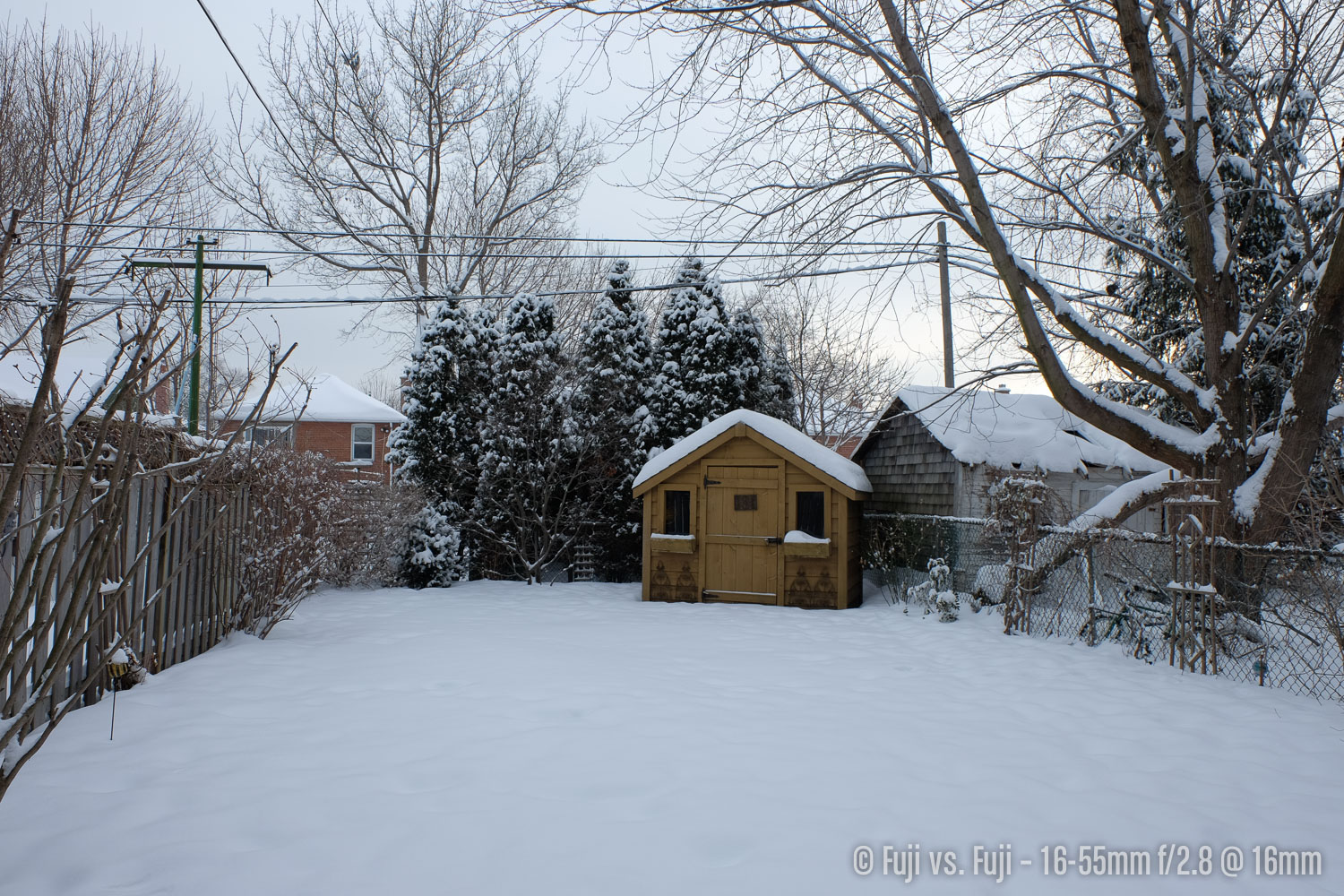


I’ve seen it written that the difference between 16mm and 18mm on APC isn’t that much. Call me crazy, but I’d say it’s significant enough that it should absolutely factor into your purchasing decisions. If you’re looking for one lens to do it all vs. supplementing with a wider prime, and you’re not concerned with reach, the XF 16-55mm F2.8 WR will definitely get you wider.
Strangely, the XF 18-135mm F3.5-5.6 OIS WR get you a bit more width than the XF 18-55mm F2.8-4 OIS will.
Telephoto
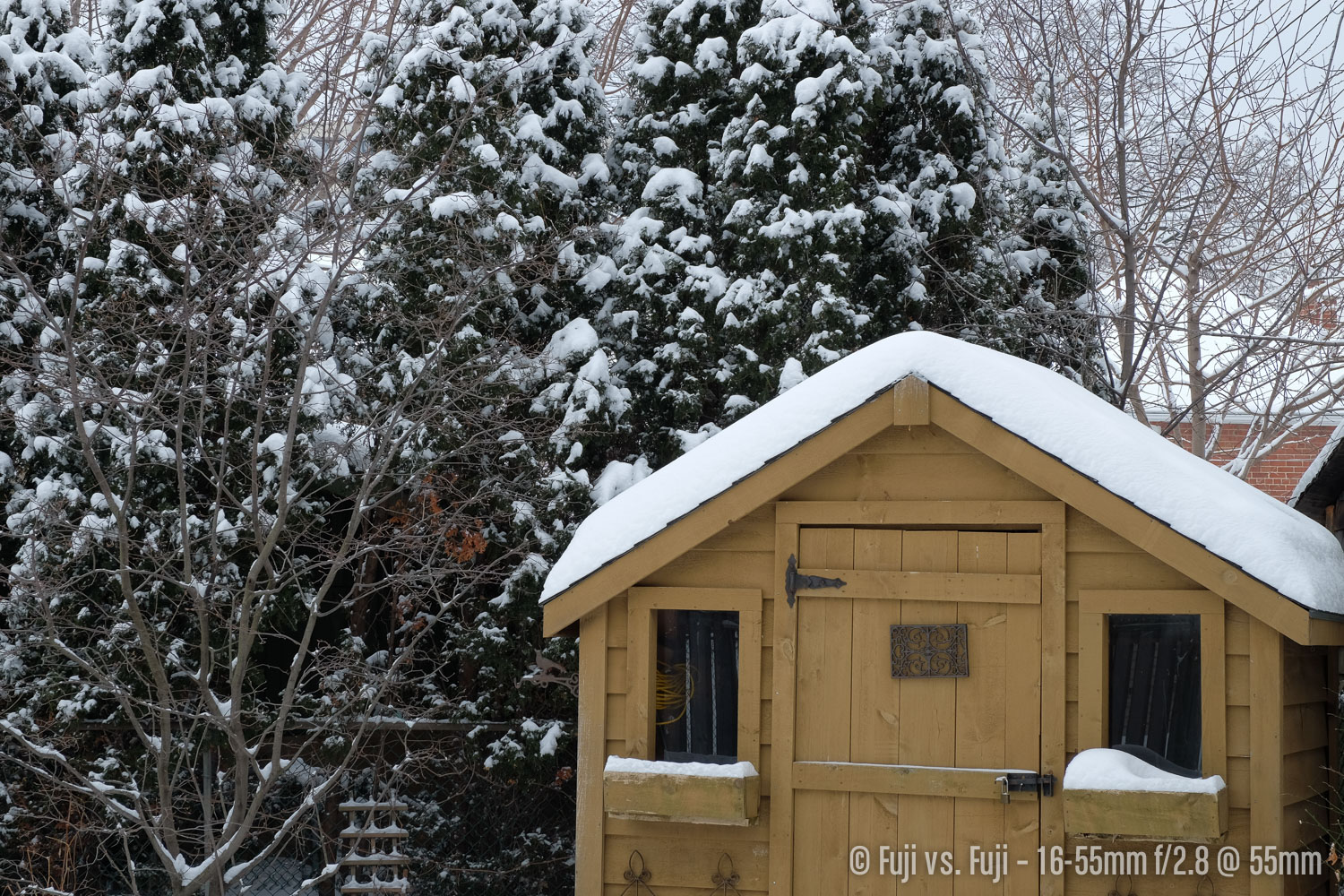
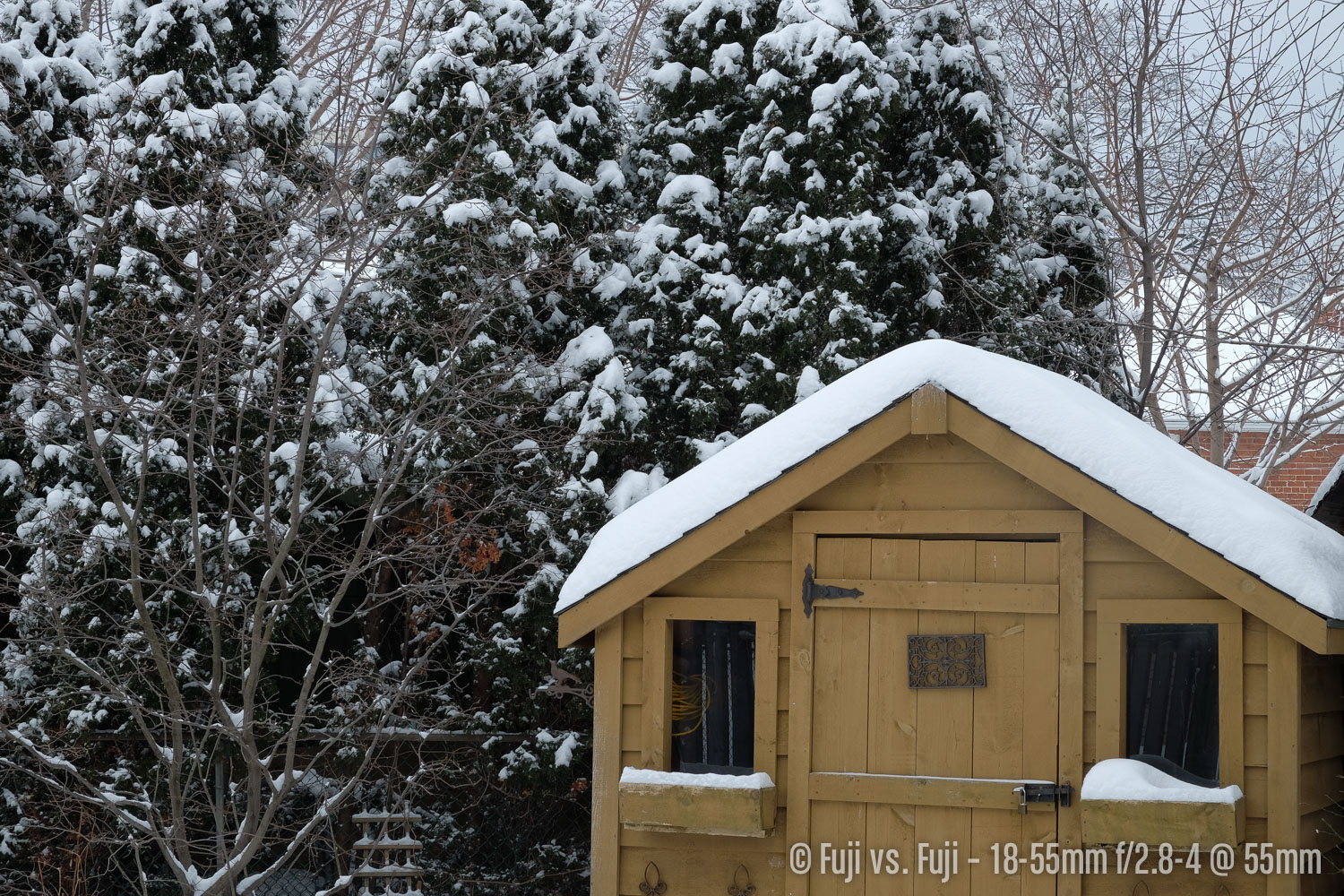
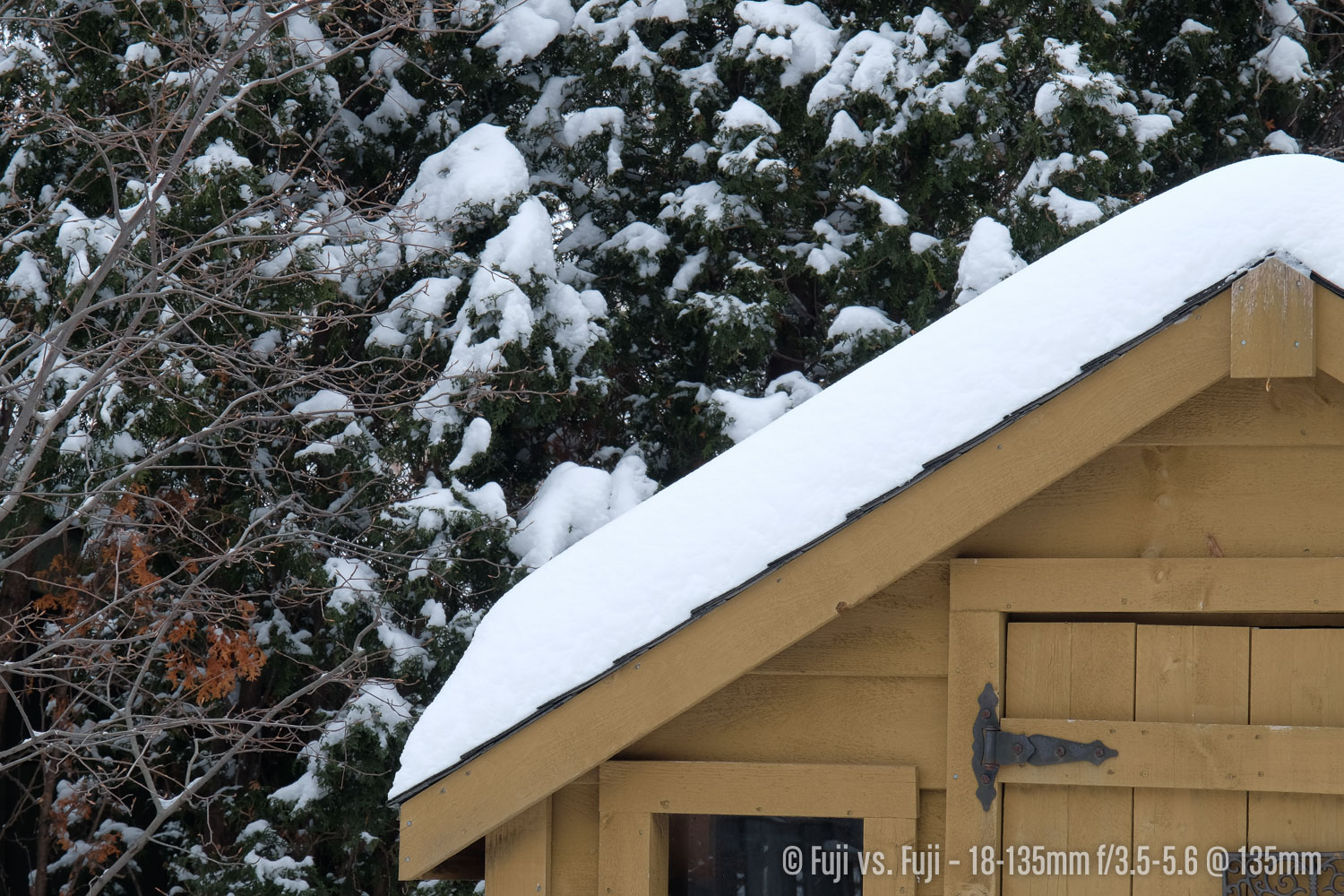
Things are pretty consistent between the pro and kit lens, save for the framing which should be consistent. My tripod didn’t move and I lined up the marking on my L-plate as usual. This isn’t the first time I’ve seen discrepancies in framing between Fuji lenses that should be identical though.
The XF 18-135mm F3.5-5.6 OIS WR shows what might be it’s only real advantage in this comparison. 135mm will obviously get you much closer to your subject than 55mm will.
Bokeh
With a maximum aperture that’s ½ a stop faster at the wide and, and up to 2½ stops faster by the time 55mm is reached, superior background separation with the XF 16-55mm F2.8 WR is a given. Here’s how things stack up. For this comparison, we'll look at crops from the image below.
Crop 1 (Click to enlarge)
Wide open
At maximum aperture, the difference is huge. The full stop advantage of the XF 16-55mm F2.8 WR does much better than the other two lenses. Between the kit zoom and the XF 18-135mm F3.5-5.6 OIS WR, it’s a fairer fight. The extra ⅓+ advantage of the XF 18-55mm F2.8-4 OIS helps it pull ahead a little, and the bokeh on the XF 18-135mm F3.5-5.6 OIS WR simply isn’t as pleasing to my eye.
f/4
Things get a little more interesting as the aperture gets closer. Of note, by 50-55mm the XF 18-135mm F3.5-5.6 OIS WR’s variable aperture has already stopped itself down to f/4.7. This lens is not the swiftest. Aperture difference aside, the XF 18-135mm F3.5-5.6 OIS WR still has the least pleasing bokeh. Comparing the kit and pro zooms, the pro zoom appears to blur background detail out a little more, but quality of the blur appears to be a little better on the XF 18-55mm F2.8-4 OIS. I’m totally splitting hairs here, but still, it’s an impressive showing from the kit lens.
f/8
With even apertures, it’s pretty much a toss up between pro and kit zoom seems. The 18-135mm brings up the rear again, but the difference isn’t as great.
Crop 2 (Click to enlarge)
The next set of crops will show detail of the trellis as well.
Wide Open
Nothing new to say on the bokeh side of things here, but the pro zoom appears to be slightly sharper than the kit zoom wide open. Both lenses are significantly sharper than the super zoom, which is quite soft at its maximum aperture of just f/4.7.
f/4(ish)
With the pro and kits zooms on equal ground, the sharpness advantage of the pro zoom becomes ever so slightly greater. In this crop I can still notice the increased blurring of the XF 16-55mm F2.8 WR, but the quality is a wash. No change with the XF 18-135mm F3.5-5.6 OIS WR here. Same soft image with poor bokeh.
f/8
By f/8, the XF 18-135mm F3.5-5.6 OIS WR catches up to the XF 18-55mm F2.8-4 OIS. The XF 16-55mm F2.8 WR is still sharper than both, and has more pleasing bokeh, but neither are by a wide margin.
Vignetting
Falloff is something I’m least concerned about. Partially because more it’s often something I end up adding to some degree in post, but mostly because it’s pretty easy to correct provided it isn’t too extreme.
Here we have a snowy image to get a sense of how much falloff we’d be dealing with. In short, I’m not concerned about vignetting with any of these lenses, but the XF 18-55mm F2.8-4 OIS performs the best, and the XF 18-135mm F3.5-5.6 OIS WR performs the poorest.



